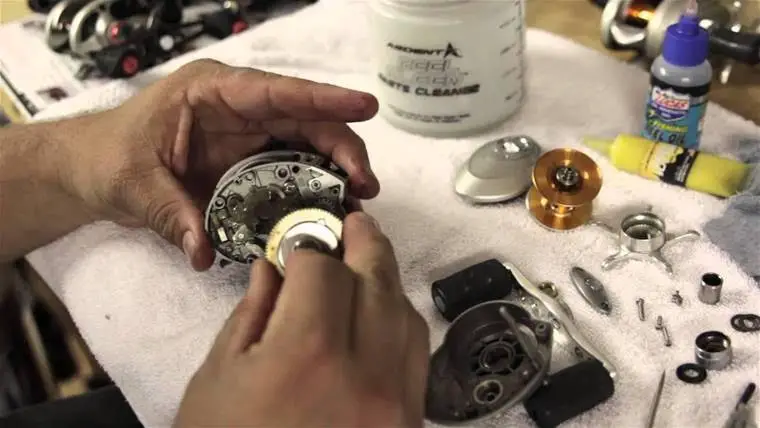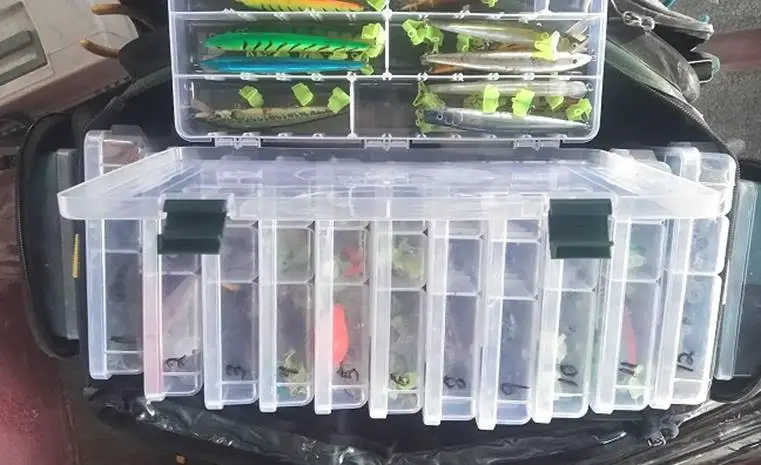Search
Latest Articles
Ten To-do things to get ready for spring bass fishing
by Rick Lawrence, March 07, 2021
1 Tackle prep
Pull all your lures out of their boxes, clean and inspect them all for cracks as well as damaged or rusty hooks. Check each hook for damage and replace all the hooks that need it, but also check that the hooks are sharp. If you can’t get each hook point to stick in your thumb nail easily take a small cross-hatch bastard file and touch them up. Some hallow baits if they get a crack can be repaired with a little super glue as long as you can get all the water out. Clean all baits that need it with some baking soda mixed with a little water to form a thick liquid and use an old tooth brush to scrub all your baits till they are clean. You need to check your split rings as well for damage and replace as needed. If your handy it all with an air brush, think about repainting any lures that the paint job has seen better days.
2 Clean your tackle boxes
Since you all ready have all your lures out for cleaning and inspection anyway, now is a great time to thoroughly clean your tackle boxes. Replace any of the boxes that are damaged.
3 Organize your tackle
If you are like most bass guys you keep your tackle in clear 3900 boxes in a canvas bag. I like to number my boxes and start with my topwater baits and work down in the water column from there. So box 1 will have all my soft topwater baits like frogs and buzz-toads, and box 2 will have all my hard surface baits like Pop Rs, Whopper Ploppers, Spooks, and such. In the 3rd box I put all my sub surface baits, like some of your hard wake swimbaits and non weighted soft plastic swimbaits. Box 4 gets all my shallow diving crankbaits. Box 5 is mid depth cranks and 6 is my deep divers. I keep this basic plan up filling boxes in order the of the depth the lure runs till I get to the baits you fish on the bottom, so all my jigs and such are in that. I do have a few special boxes though; one that has all my sinking swimbaits in and I also have a box just for all my spoons and another one for just spinnerbaits and chatterbaits.
4 Clean and re-spool your reels
Start by removing all the reels from your rods. Remove any line from the reels that is getting old before you set them aside. If the line is over 6 months old you should replace it. As let's get serious, if you only hook into one trophy fish this year or better yet, a state record fish, don't lose it over $7.00 worth of new line! Now take each reel and examine them for wear, looseness, or missing screws. Check the handles for straightness, and for ease of turning. The handles should spin around smoothly. There should only be the sound of the reel turning, not of the gears grinding or sounding dry. If you think they need it send them out for a good cleaning and lube by a reel repair company. If you think they don’t need that, clean as much of the reel as you can and look at the reel for lubrication points, and lubricate sparingly. If the reel is to be used in extremely cold weather, I recommend using graphite instead of oil. The bail should move back and forth freely and without any noise. Tie a short piece of line to the reel and slowly tighten the reel as the handle is turned. Any sudden lock-up of the reel qualifies the reel for replacement.
I always use a cheap mono backing on all my reels and spool them with about 4 cast lengths of a good braid which I use about 3 months, then run the line around a smooth pipe and walk back till you reach the end of your braid. Cut it off and retie the other end of the braid onto your backing and now you have fresh braid to work with.
5 Rod prep
Now take each rod and beginning at the top, check each eye for tightness, cracks in the material, and alignment with the remaining eyes. If you find one that is cracked, or missing the internal material, set that pole aside as you are going to have to make a decision to replace the defective eye, or remove the pole from your inventory and replace it. If you do repair the guide you might consider upgrading all of the eyes to something that is more durable. During the examination of the eyes, be sure to look for grooves in the material, which makes that eye a candidate for replacement. If the pole is multiple-piece pole make sure the pieces fit together smoothly and tightly. Make sure that you haven't inadvertently been fishing with a two different poles put together, this happens.
Now move down to the reel seat. The reel connection sleeve is the next item that needs to be looked at carefully. A cracked sleeve could also cost you that trophy fish if your reel falls off in the middle of the battle. Move to the handles, and check the material, cork, rubber or whatever your pole is constructed of. Look for looseness, cracks, or anything that might fail. Make a list of those poles requiring replacement, or back-up. Be sure to show this article to your wife to justify that every fisherman needs many rods. Like a cranking rod, a flipping rod, or a drop shot rod just to name a few, and of course some back-ups! Tell her to think of them as shoes. Would she only have one pair of shoes? I think not!
6 Boat de-winterizing
The first step to take after removing the cover, tarp or shrink-wrap is to give the boat a thorough cleaning. This includes wiping down the interior of the boat, vacuuming the carpet and power washing the exterior. If you wax your hull, now would be the best time to do it. While working on the outside of the boat, do a visual check for any gouges or cracks in the hull. Also look for missing or loose rivets. If any damage is found, outside help may be required to fix it.
You should also replace your lower unit oil and if your motor is not running as it should get it to the shop early to beat the spring rush. Install fresh spark plugs in the engine, ensuring that the "gap" is at the correct spacing (see your owner's manual for information). Also place a spare set in an emergency kit and keep on board.
Check the bilge area for any dirt or debris that may have collected over the winter. Take your boat to the car wash and use the pressure washer on it with the plug out if it’s really dirty. A very important step before making that first launch is to put the drain plug in! I never leave the plug out in the summer.
Any items that were removed for winter storage should now be placed back in the boat. This includes such things as boat seats, life vests, first-aid kits, fire extinguishers and flares. This is a good time to inspect all of your safety equipment and replace or repair if necessary. Remember to check expiration dates on flares, inspect ropes on anchors, mooring lines and check extinguishers to see if they are charged.
7 Boat Trailer's Need Spring Maintenance Too
Go over the trailers rollers or bunks replacing any parts aren't working properly. (Obviously, you will need to have the boat off the trailer to make these repairs.)
Check that all lights and turn signals work adequately. Replace any burnt bulbs if found. Also check the wiring and connectors on the trailer and the tow vehicle.
Wheel bearings they should be repacked in the spring with fresh grease, paying careful attention to torque lug nuts to appropriate levels when putting the wheels back on. Check the overall condition of your tires, which includes looking for any nails, cracking, good tread depth and air pressure. Also check for cracks in the frame or leaf springs, as well as for bad bushings. The winch strap should be in good shape, and showing no signs of fraying or unevenness. Replace if necessary. Tie-down straps should also be inspected for damage or wear and tear.
Check that the trailer winch, coupler and latch assembly is working properly. Lube as needed.. Make sure you have a inflated spare tire, jack, and lug wrench as well!
8 Check your batteries
Check all your battery fluid levels and top off any if necessary using distilled water. Also check terminals for corrosion, and clean and lubricate with grease. Although your battery should have been regularly charged over the winter, ensure that it is at full strength before placing it back in the boat. After you fully charge it, check each one with a volt meter. You should have a minimum of 13 volts for it to be good enough to hold a charge for an all day fishing trip.
9 Do your research
Do your research on what new baits or techniques might be new this year that you should try. Bassin magazine has a lure article every year that shows what’s new coming up. Do internet searches for new baits and techniques as well that you may have not heard about yet.
10 Explore maps
Use Google or Bing maps to search for new fishing spots or to learn more about the waters you normally fish. You can find all kinds of cover, down trees, weedlines, sunken islands, and other places to fish even on water you thought you were familiar with.
With these 10 things you should be well covered for a great year on the water, now all you need is skill and maybe a little luck!

